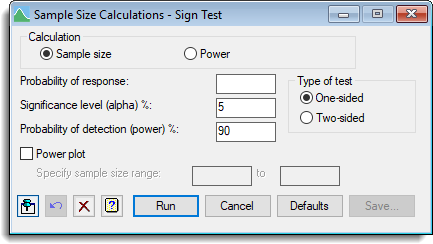Select menu: Stats | Sample Size | Sign test
Use this to calculate the number of replicates (sample size) or the power required for a Sign test. The sign test is a nonparametric test for difference in location between two related samples, or for testing the location of a single sample.
- From the menu select
Stats | Sample Size | Sign tests. - Fill in the fields as required then click Run.
After running the calculation you can save the results by clicking Save.

Calculation
Specifies the calculation to be carried out: Sample size, or Power.
Probability of response
Specifies the probability of response (i.e. the probability that an observation in one sample will be greater than the equivalent observation in the other sample) that should be detectable.
Significance level alpha
Specifies the significance level at which the response is to be tested.
Probability of detection (power)
For a sample size calculation this specifies the required probability for detection of the response (that is, the power of the test).
Power plot
When selected, produces a plot of power versus sample size. When Sample size is selected for the type of calculation the plot is generated using 11 replication values centred around the required number of replicates for the requested power. When Power is selected you can specify a range of sample size values for the plot in the spaces provided.
Sample size
For a power calculation this specifies the sample size to be used to calculate the probability of detection (power).
Type of test
Lets you choose either a One-sided or Two-sided test.
Action Icons
| Pin | Controls whether to keep the dialog open when you click Run. When the pin is down |
|
| Restore | Restore names into edit fields and default settings. | |
| Clear | Clear all fields and list boxes. | |
| Help | Open the Help topic for this dialog. |
See also
- Sample Size Save Options to store the results
- SSIGNTEST procedure